Dark Science
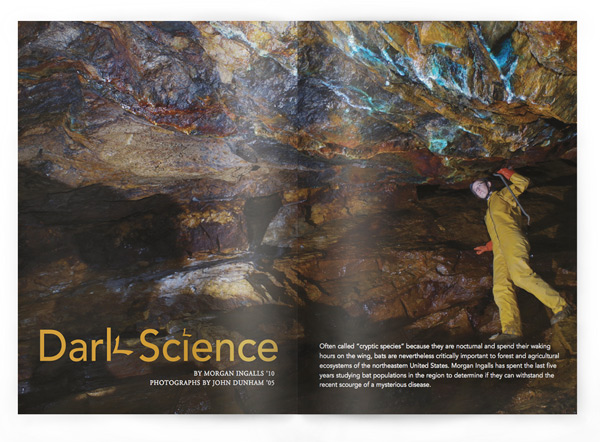
By Morgan Ingalls ’10
Photographs by John Dunham ’05
Often called “cryptic species” because they are nocturnal and spend their waking hours on the wing, bats are nevertheless critically important to forest and agricultural ecosystems of the northeastern United States. Morgan Ingalls has spent the last five years studying bat populations in the region to determine if they can withstand the recent scourge of a mysterious disease.
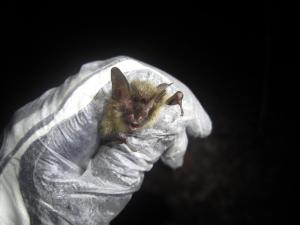
It’s mid-January in southwestern Vermont and, with the blustery windchill, the high for the day won’t make it out of the single digits. I’m helping the Vermont Fish and Wildlife Department conduct a winter hibernacula survey—in other words, I’m going to spend the day in a cave, counting bats. I’m joined by two friends, both experienced cavers, and a technician from the state agency. The cave we’re headed to is about a mile up a steep mountainside, and the ground is covered by ice and a thin layer of powdery snow, but together we claw our way to the cave entrance.
It’s a relief to get out of the wind and into the relative warmth of the 42-degree cave. Caves are the same temperature year round, making them perfect places for bats to hibernate. Vermont bat species that don’t migrate south for the winter spend the early autumn fattening up on insects, then in late October they find a cave and settle down for the winter. By dropping their body temperature to within a few degrees of the ambient temperature, they can hibernate until the insect populations return in the spring and they can have another meal.
To survive the winter by hibernating, bats have to slow down their entire physiology to conserve energy. Their heartbeats decrease from a brisk 400 beats per minute to 25 beats per minute. They also have to slow down their immune systems, which leaves them vulnerable to infection. This has recently become a major problem for bats in the eastern United States as more and more of them succumb to white-nose syndrome (WNS), one of the primary reasons for my visit to this Vermont cave.
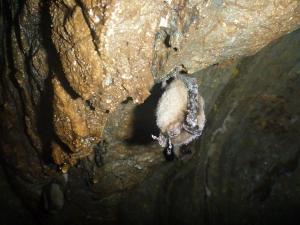
WNS is a fungal infection that attacks the face, ears, and wing membranes of bats while they hibernate. The syndrome was first seen in the Albany, New York, area in the winter of 2006, and has since spread to 29 states (including Vermont) and five Canadian provinces. While scientists are still not sure exactly how WNS kills bats, it is believed that the disease causes bats to stir from hibernation more often, which quickly drains their fat reserves. This means that many bats die from starvation and dehydration over the winter. Those bats that do make it through to spring continue to face challenges, as damage to their wing membranes leaves some unable to fly for their first meal in five months.
About 50 feet into the cave we see our first bat. It turns out to be an exciting find: a northern long-eared bat. While northern long-eared bats used to be abundant throughout the northeast, their populations have declined so drastically due to WNS that they were recently listed as federally threatened under the Endangered Species Act.
As we continue through the cave, we see three other species: little brown bats, big brown bats, and eastern small-footed bats. All three of these species have suffered population declines of varying extent due to WNS. When we climb back out of the cave after six hours underground, we’ve counted 19 bats. Ten years ago, 19 bats would hardly be worth reporting, but now, post-WNS, it’s a pretty good day.
When bats emerge from hibernation in the spring, the females move to maternity colonies where they’ll spend the next few months giving birth and caring for their pups. The maternity colonies can be up to 300 miles from their hibernation site, and females will return to the same colony year after year. Males also migrate away from the hibernation site, to foraging areas where they’ll spend the summer alone or with a few other males in “bachelor colonies.” Once juveniles are old enough to fly, males and females form fall “swarms” at cave and mine entrances, where they’ll mate and bulk up on fat for the hibernation season.
•••
Now it’s July on the coast of Maine and I’m at Acadia National Park, tracking female eastern small-footed bats in order to find maternity colonies. My team and I have been capturing bats using mist-nets: very fine nets that we place across travel corridors such as roads and trails. We open the nets around sunset and sit nearby battling the mosquitos, reading, playing cards, and checking the net every 10 minutes to see if we’ve captured a bat.
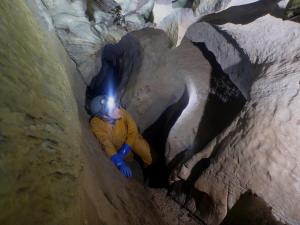
It’s my turn to check the net, and I can see when I get close enough that we’ve caught both one large and one small bat. I pull on nitrile gloves and gently grab the smaller bat. Untangling bats from mist-nets can be pretty tricky and requires a delicate touch, but also speed. Bats can become stressed if left for too long, so we try to minimize the time a bat is stuck in the net. I remove the strands of net one at a time from the bats’ feet and wings.
I bring both bats back to a camp table where we can collect some data. My co-worker, Carl, gets out a data sheet and records data while I get the smaller bat—an eastern small-footed bat—out of the paper bag it has been held in. This bat is a lactating female, which makes her of particular interest to us, since she could lead us back to a maternity colony. We also measure her forearm— the longest bone in the wing—and her ears. Then we put her in a small envelope and weigh her. She weighs about six grams, or very slightly more than a U.S. quarter. Finally, we use a small light to backlight the wings and determine how scarred they are from WNS damage.
This bat appears to be quite healthy, and we decide she’s a good candidate to track using radio-telemetry. To do this we affix a transmitter to the animal, a device that beeps on a specific radio frequency that can be detected using a receiver. The transmitters we’re using are some of the smallest available, slightly smaller than half a peanut, with a thin flexible antenna attached to one end. Altogether, the transmitters weigh about 0.3 grams, or about as much as four grains of rice.
Carl holds the bat with its wings and head down, exposing the bat’s back. Using small nail scissors, I give the bat a tiny haircut between the shoulder blades. I then put a dab of glue on the transmitter and position it onto the bald spot so the antenna runs down the bat’s back and off its tail. We put the bat back in a paper bag for 10 to 15 minutes to allow the glue to set, then release it back into the night. The transmitter battery and the glue will last three to four weeks. During that time we’ll be able to track the bat as it moves across the landscape.
The morning after we’ve trapped our female eastern small-footed bat, Carl and I drive around the park, listening for the beeps on the receiver that will indicate that we’re close to the animal. After two hours of driving, we finally pick up the signal of our bat. Using a directional antenna, we determine that the bat is roosting in a rocky area on the side of a mountain. We hike through the woods, scramble up outcrops, and finally locate our bat roosting deep in a crack on a sunny granite ledge. While we can’t actually see her, the signal from her transmitter assures us she is there.
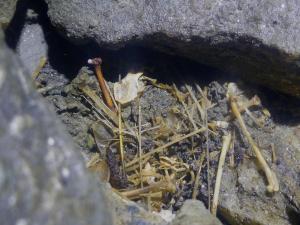
That evening, to find out if our bat has led us to a maternity colony, we hike back up to the ledge a half hour before sunset. We find a spot where the sky will backlight any emerging bats, and settle in to count. Just before sunset, we see a bat emerge, but we know it isn’t our bat since the signal on the receiver tells us she’s still in the same location. In the next 15 minutes we see six more bats emerge, including ours. We can tell when she’s left because the signal on the receiver slowly fades as she flies away from us, off into the night.
While seven bats does not make for a large maternity colony (some other species form maternity colonies in the hundreds or even thousands), this maternity colony is a good size for this species in this region. Over the next few weeks we’ll continue to track this individual, as well as others, collecting more information about how these bats use the landscape.
In addition to being important for the natural environment, bats provide a number of ecosystem services to humans. Along with reducing the number of biting insects, bats are responsible for an estimated savings of $22.9 billion per year for the agricultural industry in the United States through pest reduction. While WNS has been devastating for bat populations, it has brought much-needed funding to bat research. Unfortunately, it may be too little, too late. Since bats reproduce at a very slow rate (for most species in the northeast, females give birth to one pup per year), building populations back to pre-WNS numbers may take hundreds of years. For some species, such as the federally listed northern long-eared bat, populations may already be too small to recover.
However, bat populations in New York and New England do show some signs of recovery. Population estimates based on winter hibernacula surveys are no longer dropping, but starting to plateau. This makes some researchers hopeful that we’ll soon start to see populations increase. While recovery from WNS will take a long time, the work researchers are doing to better understand bats and how they use the landscape can lead to more effective conservation measures, which might save some species.
After I’ve finished tracking my bats around Acadia National Park, I return to Vermont for the winter. Late fall is a slow time of year for bats and bat biologists. Bats are done with their fall swarm and settled for a long hibernation. Biologists sit in their warm homes and write up reports from the summer field season. However, come January, emails start flying and trips are planned for winter hibernacula counts. Soon, I’ll be squeezing into another cave entrance to go count some bats.
Morgan Ingalls graduated from Marlboro in 2010 with a Plan in biochemistry, including a study of white-nose syndrome and population decline in bats. Morgan has worked for Biodiversity Research Institute doing summer and fall bat habitat surveys for federal agencies, and has regularly helped regional state agencies with winter bat surveys. John Dunham runs the writing center at Antioch University New England. He is also a leader of Outdoor Program caving excursions and current president of the Vermont Cavers Association.
Graphic Animal Behavior
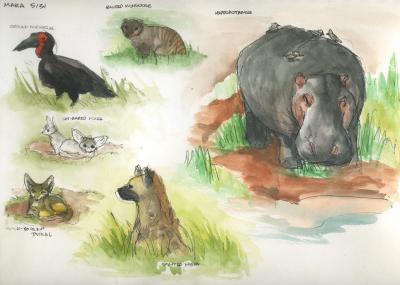 “I think spotted hyenas are really beautiful, in their own ghoulish way—I love their odd proportions,” says senior Nellie Booth, who is doing their Plan of Concentration in biology and visual arts. They spent two and a half weeks in Kenya last summer, touring Masai Mara, Samburu, and Lake Nakuru national parks and doing wildlife observations and field sketches, the basis for a narrative graphic novella about spotted hyena behavior. “I call it animal behavior fiction,” Nellie says of their biologically accurate book, titled Queen of the Mara. They are also exploring animal behavior and emotion through research on ravens; an exhibit of sculptures exploring themes of nature, birth, and death; and an educational card game about evolutionary adaptation. “I’m interested in connections between humans and nonhuman animals, including enrichment for captive animals.”
“I think spotted hyenas are really beautiful, in their own ghoulish way—I love their odd proportions,” says senior Nellie Booth, who is doing their Plan of Concentration in biology and visual arts. They spent two and a half weeks in Kenya last summer, touring Masai Mara, Samburu, and Lake Nakuru national parks and doing wildlife observations and field sketches, the basis for a narrative graphic novella about spotted hyena behavior. “I call it animal behavior fiction,” Nellie says of their biologically accurate book, titled Queen of the Mara. They are also exploring animal behavior and emotion through research on ravens; an exhibit of sculptures exploring themes of nature, birth, and death; and an educational card game about evolutionary adaptation. “I’m interested in connections between humans and nonhuman animals, including enrichment for captive animals.”
